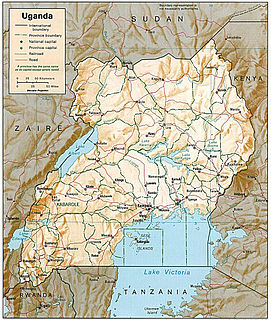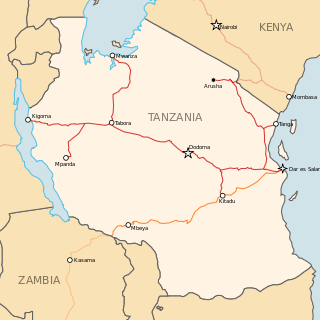The history of rail transport in Rwanda is limited to three industrial railways, and a number of proposed railway projects that, as of 2012 [update] , had not been implemented.
Rwanda has only ever had three 600 mm (1 ft 11 5⁄8 in) narrow gauge industrial railways. None of them has never offered passenger services.
The industrial railways were operated initially by:
Until 1988, all three of these businesses were united as the Régie d’Exploitation et de Développement des Mines (RÉDEMI), which also operated the three railways. However, in the ensuing 20 years the railways were severely damaged by the Rwandan Civil War and Rwandan genocide. It may well be that they are no longer in operation.
Since around the turn of the 21st century, there have been several proposals for a railway between Rwanda and neighbouring countries. The existing railway networks in nearby Uganda, Kenya and Tanzania use 1,000 mm (3 ft 3 3⁄8 in) metre gauge , but TAZARA and other nearby countries, including the Democratic Republic of the Congo (DRC) use the 3 ft 6 in (1,067 mm) gauge, leading to some potential difficulties.
As early as the 1980s, the Kagera Basin Organization carried out economic feasibility studies into a would-be KBO railway system linking Burundi, Rwanda and the DRC, but that proposed system never came to fruition. [1]
In 2000, the Common Market for Eastern and Southern Africa (COMESA) launched the Great Lakes railway project involving both rail and water transport on Lakes Tanganyika, Kivu, and Edward connecting Burundi, the DRC, Rwanda, Uganda, and Zambia. The aim of that project was to improve connections between the Great Lakes and the southern African 3 ft 6 in (1,067 mm) gauge rail network. [1] [2] COMESA commissioned a South African engineering firm, Makhosi Holdings, to carry out a feasibility study into several Great Lakes railway project routes agreed by COMESA members. [3]
Simultaneously, another team of South African engineers was engaged by COMESA to undertake a feasibility study for an alternative rail link in Rwanda, running 150 kilometres (93 mi) southeast from Kigali to Isaka, where it would have connected with the existing metre gauge Tanzanian railway network. [3] As with the would-be KBO railway system, however, the COMESA proposals were not implemented.
By 2004, the newly founded Northern Corridor Transit and Transport Coordination Authority, based in Mombasa, Kenya, was promoting a project to link Kisangani with Mombasa using a new line from Kasese to Kisangani, with feeder lines linking Kasese with Goma and then via Bukavu to Kigali and Bujumbura. [1] [2] [4] Two years later, at a meeting in August 2006 with members of the Rwanda Patriotic Front, Wu Guanzheng, of the Communist Party of China, confirmed the intention of the People's Republic of China to fund a study into the feasibility of constructing a railway connecting with the Tanzanian railway network at Isaka, and running via Kigali in Rwanda through to Burundi. [5]
There are a number of systems of transport in Burundi, including road and water-based infrastructure, the latter of which makes use of Lake Tanganyika. Furthermore, there are also some airports in Burundi.
Transport in Tanzania includes road, rail, air and maritime networks. The road network is 86,472 kilometres (53,731 mi) long, of which 12,786 kilometres (7,945 mi) is classified as trunk road and 21,105 kilometres (13,114 mi) as regional road. The rail network consists of 3,682 kilometres (2,288 mi) of track. Commuter rail service is in Dar es Salaam only. There are 28 airports, with Julius Nyerere International being the largest and the busiest. Ferries connect Mainland Tanzania with the islands of Zanzibar. Several other ferries are active on the countries' rivers and lakes.

Transport in Uganda refers to the transportation structure in Uganda. The country has an extensive network of paved and unpaved roads.

The Central Line, formerly known as the Tanganyika Railway is the most important railway line in Tanzania, apart from TAZARA. It runs west from Dar es Salaam to Kigoma on Lake Tanganyika via Dodoma. A branch leads to Mwanza on Lake Victoria.

Rail transport in Tanzania is conducted by two companies. It has historically used narrow gauge trackage, but planning and construction of new standard gauge lines is underway as of 2017.
The Northern Corridor Transit and Transport Coordination Authority (NCTTCA) is an intergovernmental body, encompassing six countries in Eastern Africa, tasked with the job of coordinating transport infrastructure improvements.

Isaka is a small town and station on the narrow-gauge Mwanza railway line of Tanzania which connects to the seaport of Dar es Salaam.

Rail transport in the Democratic Republic of the Congo is provided by the National Railway Company of the Congo, the ONATRA and the Office of the Uele Railways.
Railway stations in Uganda include:
There are several planned railway lines in Rwanda, including a line to Tanzania.

Railway stations in Tanzania include:

The East African Railway Master Plan is a proposal for rejuvenating the railways serving Tanzania, Kenya, and Uganda and adding railways to serve Rwanda and Burundi. The objective is to further the economic development of eastern Africa by increasing the efficiency and speed, and lowering the cost, of transporting cargo between major ports on the Indian Ocean coast and the interior.
Uganda Air Cargo Corporation (UACC),, is an airline based in Kampala, Uganda. It operates scheduled and charter services for both passengers and cargo.
Northern Corridor is the busiest and most important transport route in East and Central Africa, providing a gateway through Kenya to the landlocked economies of Uganda, Rwanda, Burundi and Eastern DR Congo, as well as South Sudan.
The history of rail transport in Burundi is limited to a now closed industrial railway, and a number of proposed railway projects that, as of 2012, had not been implemented.
The Isaka–Kigali Standard Gauge Railway is a planned railway line linking the town of Isaka in Tanzania to the city of Kigali in Rwanda.
The Tanzania Standard Gauge Railway is a railway system, under construction, linking the country to the neighboring countries of Rwanda and Uganda, and through these two, to Burundi and the Democratic Republic of the Congo. The new Standard Gauge Railway (SGR), is intended to replace the old, inefficient metre-gauge railway system.
The Kenya Standard Gauge Railway is a railway system that will connect Kenyan cities, and link the country to the neighboring country of Uganda, and through Uganda, to South Sudan, the Democratic Republic of the Congo, Rwanda, and Burundi. There are also plans to link to Addis Ababa, in neighboring Ethiopia to the north. The first segment, between Mombasa and Nairobi, opened passenger rail service in June 2017, and freight rail service in January 2018. Other segments are under construction or planned. The new Standard Gauge Railway (SGR), is intended to replace the old, inefficient metre-gauge railway system.
The Rwanda Standard Gauge Railway is a railway system, under development, linking the country to the neighboring countries of Tanzania and Uganda. The system is expected to link, in the future, to Rwanda's two other neighbors, Burundi and the Democratic Republic of the Congo. Through Uganda, the SGR will allow, faster access to the Kenyan port of Mombasa, Rwanda's primary access to the oceans. With no previously existing railway network, Rwanda is developing its railway system from scratch.
|newspaper= (help)|work= (help)![]()
This article is based on a translation of the German Wikipedia article Schienenverkehr in Ruanda as at September 2012.